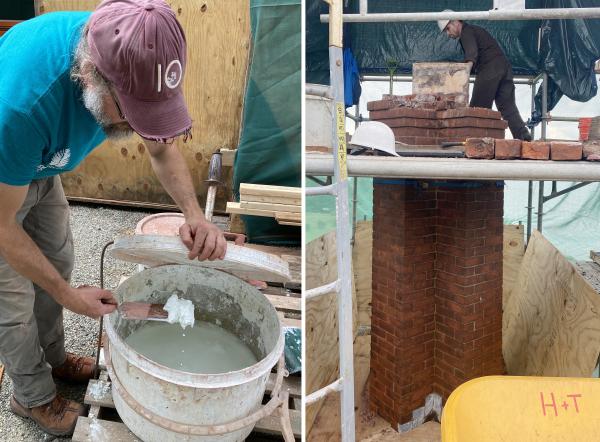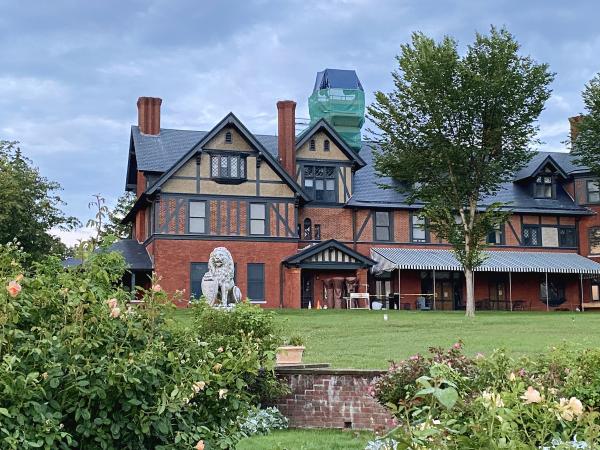Bravo to Tom and his team at Hawk & Trowel and Restoration Masonry for their cautious and dedicated work in restoring the eleven (!) chimneys of Shelburne House, as well as to Holly Brough for telling us all about this intricate and important project to preserve the house we all love.
Revitalizing the Inn's Chimneys
The chimneys—there are 11 of them—are original to the house, which was first built in 1887-1888, then greatly expanded and altered at the end of that century. When the house was converted to an inn in 1985-1986, the chimneys received some attention, but those repairs are now 35 years old, with only minor interventions since.
We all may be tired of extracting silver linings from the pandemic, but the closure of the Inn these past two seasons gave us the opportunity to focus on restoring the chimneys.
Tom Corr and his team at Hawk & Trowel Restoration and Masonry in Richmond, VT assessed the chimneys last November. (“Hawk” doesn’t refer to a bird of prey. It’s the flat, square palette that masons mix their mortars on.) They found failing mortar, and in some cases, loose or failing brick. “All the chimneys were in pretty rough shape,” Tom recounts.
Why? In a word, water. “The Northeast is brutal to buildings,” Tom says, “especially masonry.” He explains, “All buildings need to breathe, because human respiration, cooking, washing--all produce humidity that needs to escape.” But as water freezes and thaws, condenses and evaporates, it can grind up the masonry it's moving through. Heat from regular chimney use helps dry out mortar, extending its life. But Shelburne House was in significant disrepair and stood idle before its transformation into an inn, and now, few chimneys are actively used, so water has compromised both bricks and mortar.
Repairs to both bricks and mortar began this spring. Working their way across a roofscape of turrets, dormers, and slopes, the team installed counterflashing, the metal sheeting that keeps water out where the chimney meets the roof. By early summer, they had moved on to rebuilding several chimneys, using original brick if possible, and replacement brick if not. Some chimneys were dismantled right down to the roofline. Along the way, the team has been repointing (touching up) mortar as needed, and stabilizing crowns (the slab of concrete that tops each chimney).
Replacement bricks are tricky, too. Made 100+ years after the originals, using different methods and source material, modern-day bricks can differ from their predecessors in shade, shape, and strength. It can be challenging to seamlessly integrate them into the existing brickwork.
But Tom is up to the challenge, and enjoys it. “There’s not much creativity in the final product,” he explains, “but there’s a lot of creativity in the process.”
There’s also creativity in juggling the logistics of working on a historic structure in Vermont, one whose grounds and gardens have been enjoyed by the public all season. There’s limited electrical and water resources, their staging area is a short drive away, and they’ve had to shrink their construction footprint for busy weekends.
And of course, there’s the weather. Thunderstorms, rainy days, and high temperatures have all impacted their schedule. During one stretch of heat, the mortar was setting up so fast that any mislaid brick became an instant roadblock: the team would have to stop, carefully pry the brick off its bed, scrape the mortar, then lay down another.
The weather will also dictate when the crew wraps up for the season, probably by the end of October. (Just as high temperatures dry the mortar too fast, cold stretches don’t allow the mortar to set at all.) When they’re done, the Inn’s chimneys will be rebuilt, stabilized, and ready to stand dry and strong well into the future.
We anticipate the Inn opening on schedule in May 2022!
Comments
Excellent report. Great technical explanation
Very interesting report on the chimneys.
I really enjoyed the window into the Inn's restoration process and progress. Tom Corr has the right attitude for sure. I am sure Martin Tierney is looking upon the work with a great big smile.
J
Lisa and I were married in what is now the dining room at what we knew as the Big House in those days, October 12th 1974. In order for many of our guests to stay in the house many of the fire places that had not been used for years were checked and lit. Glad to see you've had a chance to take advantage of the Inn being closed.
Thank you for sharing this informative article about chimneys. I hope there are a lot of chimney contractors that could read this and be guided accordingly. https://www.grandprairiemasons.com/chimneys







